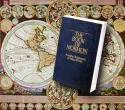| Answers portal
|
Book of Mormon
Geography
|

|
 RESOURCES RESOURCES
|
|
Geography:
DNA:
Archaeology:
Lamanites in North America:
Other:
|
 PERSPECTIVES PERSPECTIVES
|
 MEDIA MEDIA
|
 OTHER PORTALS OTHER PORTALS
|
|
|
This page is based on an answer to a question submitted to the FAIR web site, or a frequently asked question.
This article is a draft. FairMormon editors are currently editing it. We welcome your suggestions on improving the content.
Question
Joseph Smith reportedly found the bones of an individual named "Zelph," during the Zion's camp march. Does this have implications for Book of Mormon geography?
Answer
The most common version of this story is found in the History of the Church.[1] It should be noted, however, that the History of the Church version was created by amalgamating the journal entries of several people:
- Wilford Woodruff,
- Heber C. Kimball,
- George A. Smith,
- Levi Hancock,
- Moses Martin,
- Reuben McBride.[2]
[needs work]
William Hamblin described some of the difficulties with this story:
- many significant qualifiers were left out of the printed version [of this account]. Thus, whereas Wilford Woodruff's journal account mentions that the ruins and bones were "probably [related to] the Nephites and Lamanites," the printed version left out the "probably," and implied that it was a certainty. [There are] several similar shifts in meaning from the original manuscripts to the printed version. "The mere 'arrow' of the three earliest accounts became an 'Indian Arrow' (as in Kimball), and finally a 'Lamanitish Arrow.' The phrase 'known from the Atlantic to the Rocky Mountain,' as in the McBride diary, became 'known from the Hill Cumorah' (stricken out) or 'eastern sea to the Rocky Mountains.' " The point here is that there are many difficulties that make it nearly impossible for us to know exactly what Joseph Smith said in 1834 as he reflected on the ruins his group encountered in Illinois.[3]
Endnotes
- [note] Joseph Smith, History of The Church of Jesus Christ of Latter-day Saints, 7 volumes, edited by Brigham H. Roberts, (Salt Lake City: Deseret Book, 1957), 2:79–80. Volume 2 link
- [note] Kenneth W. Godfrey, "The Zelph Story," Brigham Young University Studies 29 no. 2 (1989), 31–56.off-site GL direct link
- [note] William J. Hamblin, "Basic Methodological Problems with the Anti-Mormon Approach to the Geography and Archaeology of the Book of Mormon," Journal of Book of Mormon Studies 2/1. (1993). [161–197] link
Further reading
FAIR wiki articles
Template:BoMGeographyWiki
FAIR web site
External links
- Kenneth W. Godfrey, "What is the Significance of Zelph In The Study Of Book of Mormon Geography?," Journal of Book of Mormon Studies 8/2 (1999). [70–79] link
- Kenneth W. Godfrey, "The Zelph Story," Brigham Young University Studies 29 no. 2 (1989), 31–56.off-site GL direct link
Printed material
- Donald Q. Cannon, "Zelph Revisited," in Regional Studies in the Latter-day Saint Church History: Illinois, edited by H. Dean Garret (Provo, Utah: Department of Church History and Doctrine, Brigham Young University, 1995), 57–109. GospeLink GL direct link


